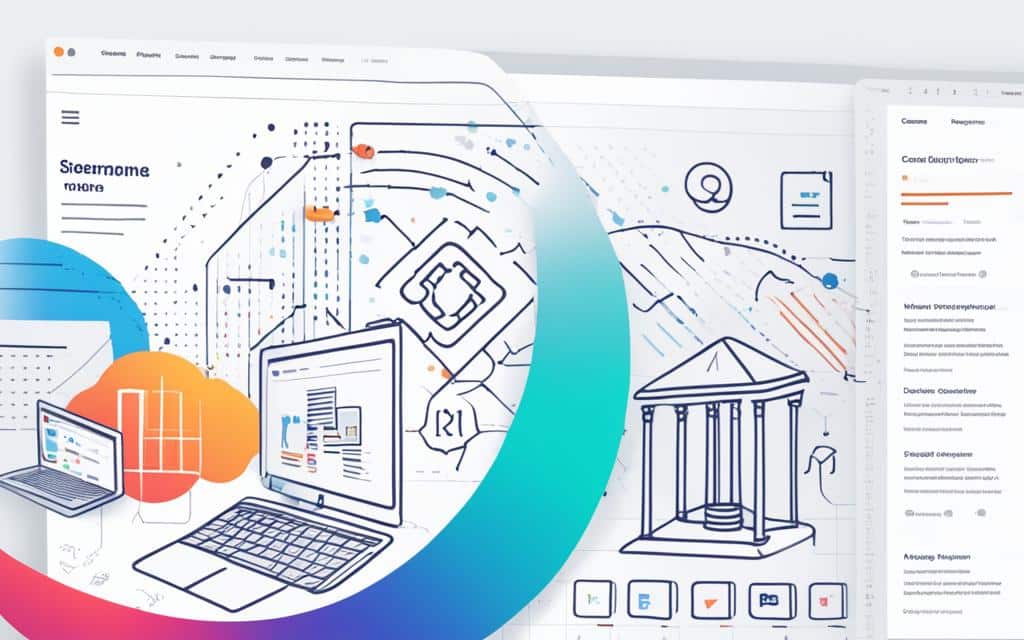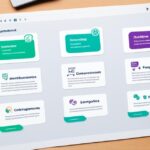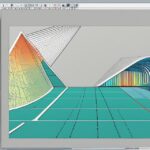Table of Contents
Design collaboration tools are essential for streamlining workflows and enhancing collaboration in design projects. These cloud-based tools enable teams to work together efficiently, connect with stakeholders, and ensure seamless project execution. From design prototyping to feedback and approval management, these tools provide a centralized platform for designers, clients, and collaborators to collaborate effectively in the cloud.
Choosing the Right Design Collaboration Tool
When selecting a design collaboration tool, there are several factors to consider. Integrations with other platforms and departments are crucial for syncing workflows and automating processes. Single sign-on (SSO) capabilities enhance security and streamline access to tools. Using products within your existing suite, such as Microsoft 365 or Google Workspace, can increase productivity and reduce costs. Additionally, finding tools that solve multiple problems, like UXPin with its comprehensive design features, can further streamline design collaboration.
UXPin Merge: Bridging the Gap Between Design and Development
UXPin Merge is a powerful design technology that acts as a bridge between the realms of design and development. It enables designers to seamlessly sync their design work with the development process, resulting in a cohesive and efficient workflow. By bringing harmony between these two critical aspects, UXPin Merge promotes collaboration, increases productivity, and ensures a consistent user experience.
One of the key benefits of UXPin Merge is its ability to create a single source of truth for design and development teams. By importing a component library hosted in a repository, designers and engineers can utilize the same UI elements throughout the design process and front-end development. This synchronization eliminates the risk of inconsistencies and facilitates a cohesive visual language across the entire project.
With its comprehensive features, UXPin Merge serves as an all-in-one design collaboration tool. It includes design systems that allow designers to create and manage shared styles, ensuring consistency across different design files. Wireframing capabilities enable designers to rapidly build low-fidelity layouts, providing a solid foundation for the design process. The interactive prototyping features enable designers to create interactive and realistic prototypes, enhancing collaboration and user testing.
Other Design Collaboration Tools for Streamlined Workflows
In addition to UXPin Merge, there are several other design collaboration tools available that can streamline workflows and enhance team collaboration. These tools provide designers, engineers, and other team members with a range of features to improve communication, foster creativity, and simplify project management. Let’s explore some of these tools:
Storybook
Storybook is a sandbox environment that allows designers and engineers to develop UI elements in isolation. It facilitates collaboration between both parties by providing a dedicated space for creating and testing components. With Storybook, teams can iterate on designs, gather feedback, and ensure consistent UI implementation.
Miro and Google Jamboard
Miro and Google Jamboard are cloud-based ideation tools that facilitate collaboration and brainstorming sessions. These tools provide virtual whiteboards where teams can capture and share ideas, create visual diagrams, and collaborate in real-time. Miro and Jamboard enable teams to work together creatively, regardless of physical location.
Slack and Google Chat & Spaces
Slack and Google Chat & Spaces are popular communication and collaboration platforms used by teams worldwide. These tools offer real-time messaging, file sharing, and integration capabilities, allowing teams to stay connected and share updates seamlessly. With features like channels, threads, and video calls, teams can collaborate effectively and keep projects on track.
Notion and Jira
Notion and Jira are project management tools that are widely used in design projects. Notion provides a flexible workspace where teams can create, organize, and collaborate on documents, tasks, and notes. Jira, on the other hand, offers extensive project management features designed for software development teams. With integrations and customizable workflows, Notion and Jira help teams stay organized and ensure efficient project execution.
Trello and Asana
Trello and Asana are task management tools that offer specific features tailored for design projects. These tools allow teams to create, assign, and track tasks, set deadlines, and manage project workflows. With intuitive interfaces and collaboration features, Trello and Asana help teams prioritize work and stay focused on project goals.
ProofHub
ProofHub is a comprehensive product management platform that supports design, engineering, and product teams. It provides features for task management, collaboration, file sharing, time tracking, and more. With ProofHub, teams can streamline project communication, centralize project-related information, and ensure smooth collaboration across all stages of the design process.
Comparison of Design Collaboration Tools
| Tool | Main Features |
|---|---|
| Storybook | Sandbox environment for developing and testing UI elements |
| Miro and Google Jamboard | Cloud-based collaborative ideation tools for whiteboarding and brainstorming |
| Slack and Google Chat & Spaces | Real-time messaging, file sharing, and integration capabilities for seamless collaboration |
| Notion and Jira | Project management tools for organizing tasks, documents, and notes |
| Trello and Asana | Task management tools with intuitive interfaces and collaboration features |
| ProofHub | Comprehensive product management platform for streamlined collaboration and project management |
Each of these design collaboration tools offers unique features and benefits that can enhance team collaboration, streamline workflows, and improve project outcomes. By selecting the right tools based on your team’s needs, you can create an efficient and productive design workflow.
Enhancing Design Workflows with Merge
UXPin Merge provides designers with a range of benefits that not only enhance design workflows but also improve project outcomes. One key advantage of Merge is the ability to create higher fidelity prototypes using the same UI components as engineers. This alignment between design and development empowers designers with increased confidence in the final product, leading to higher quality feedback from stakeholders.
“With UXPin Merge, we’ve seen a significant improvement in the accuracy and realism of our prototypes. It has revolutionized our design process and elevated the level of collaboration within our team.” – Sarah Thompson, Senior Designer at ABC Design Studio
In addition, Merge facilitates improved feedback and collaboration among designers, product teams, engineers, and stakeholders. By centralizing the design process within a single collaborative tool, UXPin Merge enables seamless communication, efficient feedback loops, and enhanced collaboration throughout the design and development lifecycle.
Empowering Design Teams with a Drag-and-Drop Design Environment
Another noteworthy feature of UXPin Merge is its intuitive drag-and-drop design environment. This user-friendly interface makes prototyping accessible to more team members, regardless of their technical expertise. The simplified workflow reduces the learning curve, enabling designers to create interactive prototypes efficiently and effectively.
With Merge’s drag-and-drop functionality, designers can easily experiment with different design concepts, iterate on ideas, and rapidly create interactive prototypes for user testing and stakeholder reviews. This agility in the design process not only accelerates project timelines but also promotes innovative thinking and ideation.
| Merge Benefits | How it Enhances Workflows |
|---|---|
| Higher Fidelity Prototypes | By using the same UI components as engineers, designers create more realistic and accurate prototypes that align closely with the final product. |
| Improved Feedback and Collaboration | Merge’s centralized platform and streamlined communication channels foster efficient feedback loops and collaboration among design teams, product teams, engineers, and stakeholders. |
| Advanced Collaborative Design Tool | With its comprehensive set of features, Merge serves as an advanced design collaboration tool that supports the end-to-end design and development process. |
Conclusion
Cloud design collaboration tools are essential for effective team collaboration, streamlined workflows, and seamless project execution. These tools provide a centralized platform for designers, clients, and collaborators to work together efficiently in the cloud. By improving communication, sharing ideas, and managing files effectively, these tools enhance productivity and drive success in the digital age.
Whether you choose the comprehensive features of UXPin Merge or opt for specialized tools like Storybook, Miro, or Trello, incorporating design collaboration tools into your design process can significantly improve project outcomes. The ability to collaborate in real-time, iterate on designs, and gather feedback from stakeholders leads to better results and higher client satisfaction.
With the increasing need for remote work and distributed teams, cloud design collaboration tools have become indispensable in the design industry. They facilitate effective team collaboration regardless of geographical location, enabling designers to work together seamlessly on projects, streamline workflows, and ensure the successful execution of design initiatives.
FAQ
What are design collaboration tools?
Design collaboration tools are cloud-based platforms that enable teams to work together efficiently, connect with stakeholders, and ensure seamless project execution in design projects.
Why are integrations important in design collaboration tools?
Integrations with other platforms and departments are crucial for syncing workflows and automating processes in design collaboration tools.
How does single sign-on (SSO) enhance design collaboration?
Single sign-on capabilities enhance security and streamline access to design collaboration tools.
What is the benefit of using design collaboration tools within your existing suite?
Using design collaboration tools within your existing suite, such as Microsoft 365 or Google Workspace, can increase productivity and reduce costs.
Can design collaboration tools solve multiple problems?
Yes, design collaboration tools like UXPin with its comprehensive design features can solve multiple problems and further streamline design collaboration.
What is UXPin Merge?
UXPin Merge is a powerful design technology that bridges the gap between design and development, creating a single source of truth for designers and engineers.
How does UXPin Merge streamline design workflows?
UXPin Merge streamlines design workflows by enabling designers and engineers to use the same UI elements during the design process and front-end development.
What are the features of UXPin Merge?
UXPin Merge offers features for design systems, wireframing, mockups, interactive prototyping, and testing, making it an all-in-one design collaboration tool.
What are some other design collaboration tools available?
Other design collaboration tools include Storybook, Miro, Google Jamboard, Slack, Google Chat & Spaces, Notion, Jira, Trello, Asana, and ProofHub.
How does UXPin Merge benefit design workflows?
UXPin Merge enhances design workflows by allowing designers to create higher fidelity prototypes and receive higher quality feedback from stakeholders.
How does Merge improve collaboration in design projects?
Merge improves collaboration among designers, product teams, engineers, and stakeholders by facilitating better feedback and communication.
What is the advantage of using Merge for prototyping?
With its drag-and-drop design environment, Merge makes prototyping accessible to more team members, increasing productivity and reducing the learning curve.
Why are cloud design collaboration tools important?
Cloud design collaboration tools are essential for effective team collaboration, streamlined workflows, and seamless project execution in the digital age.
How do design collaboration tools enhance team communication?
Design collaboration tools improve team communication by providing a centralized platform for sharing ideas, managing files efficiently, and increasing productivity.
How can design collaboration tools enhance project outcomes?
Incorporating design collaboration tools into the design process can significantly enhance project outcomes by improving communication, sharing ideas, and managing files efficiently.













